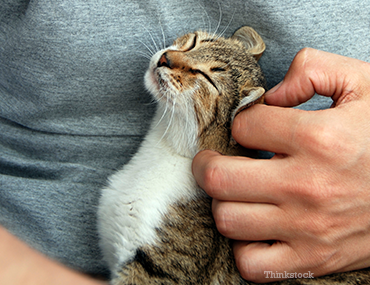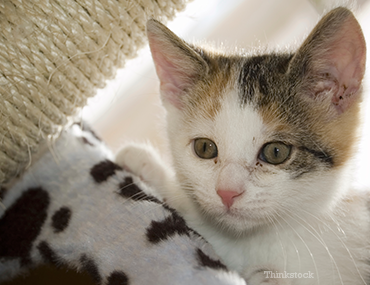For more from Dr. Justine Lee, find her at www.drjustinelee.com or on Facebook!
If you own a cat, this blog is a must read!
Before applying any topical flea and tick medication to your cat, pay heed.
One of the most commonly presenting emergencies I see is accidental poisoning of cats by their well-intentioned pet owners. They often put “small dog” flea medication onto their “big cat,” without appropriately consulting with their veterinarian or reading the label carefully, resulting in severe poisoning in cats.
The flea and tick topical spot-on medication most commonly implicated? Drugs from the pyrethrin and pyrethroid family. These active ingredients are commonly found in household insecticides, sprays, and topical spot-on medications. These chemicals are very safe for dogs, but should never be used for cats.
So what exactly are these chemicals? Pyrethrins are actually natural chemicals derived from the Chrysanthemum flower (commonly called the “mum”), while pyrethroids are synthetic derivatives (made by man). Common chemical names for pyrethroids include the following – note, they typically end with a “thrin.”
Allethrin
Deltamethrin
Cypermethrin
Permethrin
Cyphenothrin
Many of these active ingredients are used in high concentrations in flea and tick topical spot-on medications for dogs without any problem; however, in certain species (like cats and fish), this high level of a concentrated pyrethroid can result in severe poisoning. Other sources of these chemicals include household insect sprays and topical flea sprays and shampoos; however, these are typically in very low concentrations (<1% pyrethrins or pyrethroids) and are generally safe for cats and dogs.
 Unfortunately, cats have an abnormal liver metabolism and cannot handle high concentrations of pyrethroids (or other drugs). As a result, cats develop poisoning when exposed to these chemicals.
Unfortunately, cats have an abnormal liver metabolism and cannot handle high concentrations of pyrethroids (or other drugs). As a result, cats develop poisoning when exposed to these chemicals.
Signs of poisoning in a cat can be severe and include the following:
Agitation
Drooling or vomiting (typically due to grooming the product off and tasting the bitter chemical)
Lethargy
Facial twitching
Ear twitching
Hiding
Walking "drunk"
Gastrointestinal signs (such as inappetance, anorexia, vomiting, diarrhea, etc.)
Muscle tremors
Warm to the touch (secondary to tremoring and hyperthermia)
Seizures
Death
If you accidentally applied dog flea and tick medication to your cat, contact your veterinarian, an emergency veterinarian, or an animal poison control center immediately. The sooner you treat it, the less poisonous it may be and the less expensive it may be to treat.
Treatment of pyrethrin or pyrethroid poisoning in cats includes the following:
Bathing your cat
Keep in mind that cats are very hard to bathe at home, and when in doubt, you should never put yourself (or your cat) at risk of harm. If you can’t bathe your cat, seek immediate veterinary attention so they can bathe your cat to remove the topical spot-on medication. Note that since the flea and tick medication is very oily, it will not come off if you're only using water or a dog/cat shampoo alone. Your cat should be bathed with a mild liquid dish soap (used specifically to wash the dishes in the sink) such as Dawn.™
Seek immediate veterinary attention
As mentioned above, your veterinarian can decontaminate your cat quickly and efficiently to remove the chemical.
 Hospitalization
Hospitalization
If your cat has clinical signs (e.g., tremors, seizures), hospitalization is a must to stop the tremors with muscle relaxants (e.g., methocarbamol) or antiseizure medication (e.g., phenobarbital, valium). These medications should only be administered by a veterinarian, unless otherwise directed by your veterinarian. In addition, further treatment from your veterinarian may include intravenous fluids, blood sugar monitoring, temperature support and monitoring, and blood pressure monitoring.
Prevention
When in doubt, never apply a product to your pet without carefully reading the product label. If you’re not sure, check with your veterinarian first. Also, make sure you know the accurate weight of your pet before you apply any medication; pet owners often erroneously “guess” their pet’s weight, resulting in under-dosing or more commonly, overdosing with medications.
When in doubt, talk to your veterinarian about the safest type of flea and tick medications to use on your cats and dogs. If you own both species, you should separate your dog from his buddy cat until the spot-on product is completely dried so you can prevent chemical exposure to your cat.
Finally, help save those fish out there and protect the environment – never let your dog jump right into the lake, pond, or ocean after you apply a flea and tick medication – wait at least 24 hours for the product is dry. Otherwise it can result in poisoning of the fish in the water.
Keep all species safe by knowing these tips!
Dr. Justine Lee
If you have any questions or concerns, you should always visit or call your veterinarian – they are your best resource to ensure the health and well-being of your pets.
| Beware the Bug See why the right flea and tick medication is so important Fleas 101 Or learn more about dogs and parasites > |

